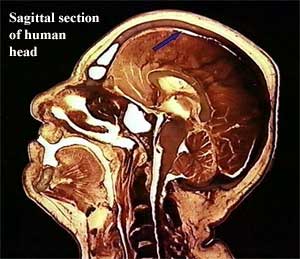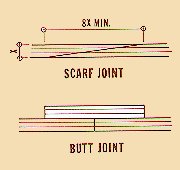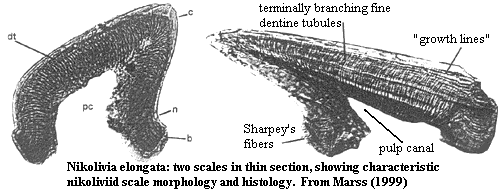| Glossary | ||
| The Vertebrates | SA-SP |
| Vertebrates Home | Vertebrate | Vertebrate | Bones | Time |
For most phrases beginning with directional words, e.g. "posterior," "dorsal," "external," etc., or some generic anatomical terms, e.g., "vena," look under the next word in the phrase. However, note that this convention is not used with complete consistency in this Glossary.

$ abbreviation indicating a synapomorphy.
S abbreviation for the Silurian Period.
Sabkha "Sabkha is an Arabic name for a salt-flat that has come into general use in sedimentology following classic research in the United Arab Emirates of the Arabian Gulf in the 1960s and later. They are flat and very saline areas of sand or silt lying just above the water-table and often containing soft nodules and enterolithic veins of gypsum or anhydrite. A thin crust of halite and gypsum may be present in some parts. Many ancient evaporites show sedimentary feature of sabkhas, such as gypsum nodules." Sabkha and Desert Features - Introduction
Sacculus one of the maculae, vaguely sac-like areas of the vestibular apparatus in the inner ear involved in the perception of linear acceleration, orientation in a gravity field, and low-frequency or high-volume sounds. See The Ear.
Sacral Of or pertaining to the sacrum - the region of the vertebral column involved with the pelvic girdle, between the dorsal (or, in mammals, the lumbar) and the caudal vertebrae. The sacrals or sacral vertebrae are the vertebrae associated with the pelvic girdle. They are usually fused to each other and to the ilium.
Sagittal Dorsoventral. Usually used to refer strictly to a dorsoventral structure or section at the midline, where parasagittal refers to a dorsoventral structure or section parallel to the midline.

Sagittal Crest A longitudinal median bony ridge dorsal to the braincase. Often formed by a coalescence of temporal ridges. Compare: nuchal ridge -- same, but transverse
Sakarya Continent "southern part of northwest Turkey, was a Jurassic-Early Cretaceous [through Eocene -- see Maas et al. 2001)] carbonate platform micro-continent distant from terrestrial sediment influx." Mekik et al.. The geological history of this area seems quite complex.
Saltatorial Adapted for leaping locomotion.
Sand sedimentary particles in the size range 0.0825 (i.e. 1/16) to 2.0 mm. See clay, silt, gravel.
Sandbian Age first age of the Late Ordovician, 461-456 Mya. See Sandbian.
Sanping Formation middle Cretaceous of China.
Santa Lucía Formation Early Paleocene of Bolivia. Most famous for its Tiumpampan exposure with numerous mammal fossils.
Santana Formationmiddle or Late Cretaceous Cenomanian) of northeastern Brazil. Pterosaurs. Noted for soft tissue preservation.
Santonian an age of the Late Cretaceous (, about 85.8-83.5 Mya. See Santonian.
Sau Khua Formation Late Cretaceous (Barremian) of northeastern Thailand.
Scala media the inside of the lagena or cochlea, conceived as a fluid compartment of the inner ear. It contains the Organ of Corti. See the Ear.
Scala tympani The compartment of the inner ear adjacent to the fenestra rotunda (or equivalent). See the Ear.
Scala vestibuli The compartment of the inner ear adjacent to the fenestra ovalis. It contains the vestibular apparatus. The scala tympani is immediately impacted by vibration of the middle ear ossicles. See the Ear.

Scansorial Pertaining to arboreal mammals that climb by means of sharp recurved claws. e.g. tree squirrels.
Scaphium one of the Weberian ossicles in Otophysi, derived from the first neural arch. See also image at claustrum.
Scaphoid in mammalian osteology, one of the carpal bones. Normally articulating distally with the trapezium and trapezoid and proximally with the radius. See image at unciform.
Scapula One of the two main bones of the pectoral girdle. In many forms the scapula is the principal link between the forelimb and the axial skeleton. Proximally, it normally participates in the glenoid (articulation of the humerus) and articulates with the clavicle (by way of an acromion process) and the coracoid. Axially, it articulates with the ribs and/or spine. The scapula may be fused with the coracoid, the second main bone of the pectoral girdle, to form a scapulocoracoid. See example of mammalian scapula at supraspinous fossa.
Scapular spine a distinct ridge running along the external length of the scapula, characteristic of therian mammals. See image at supraspinous fossa.
Scapulocoracoid either a fusion of the scapula and coracoid (the two main bones of the shoulder girdle), or the scapula & coracoid considered as a single structural unit.
Scapulocoracoid notch a notch on the anterior of the shoulder girdle, where the scapula & coracoid meet -- opposite the glenoid (articulation for the humerus).

Scarf Joint a joint formed by a long overlap between two bones.
Scat Craig late Frasnian locality near Elgin, Scotland. Lag deposits of reworked material transported from an unknown upstream location. Ahlberg 1998).
SCC see semi-circular canal.
Schizocoely see Early Development Terms.
Schizognathal palatines do not meet at the midline.
Schizorhinal in osteology, having separated nasals; in general anatomy, having slit-like nostrils.
Schreckstoff "An alarm response in these fishes is the result of an alarm substance (Schreckstoff) being introduced into the water via rupture of specialized dermal club cells. Presumably fish are traveling in some kind of school or shoal when one or more of them are damaged (attacked). Release of Schreckstoff into the water (Schreckreaktion) results in the remaining conspecifics making a variety of coordinated escape actions. It is also believed that a predator that has recently consumed an Ostariophysian will secrete Schreckstoff in its feces, also warning other Ostariophysians of the predator's presence." Lab 5 [former page].
Sclero- a Greek combining form meaning "hard." The Latin equivalent would be dura-.
Sclerotome see Early Development Terms.
Sclera (1)a recess holding the eye; (2) the circle of bone(s) supporting the orbit; (3) any recess or compartment.
Sclerotic ring a ring of bone or small bones inside the sclera, presumably acting to support the eye.
Scrofic after Sus scrofa, one of two morphotypes of the canine found in suoids. In scrofic canines, the tooth is approximates an equilateral triangle in cross-section. The lingual face is broadest, and the posterolateral face is second broadest. As opposed to verrucosic.
Sebaceous gland (a) generic name for any oil-producing gland, not a particular structure. (b) in mammals, sebaceous glands refer to a particular structure which looks a bit like a bunch of grapes and which produce skin oils and zits. Homologues of the mammalian sebaceous glands probably include the mammary glands and scent glands.
Secodont in mammals, cheek teeth with a cutting or shearing action adapted for a carnivorous diet. Same as sectorial.
Secondary feathers the flight feathers originating on the ulna.
Secondary Palatestructural separation of the mouth and upper throat from the nasal passages). Functionally, a separation of respiration and feeding -- an important adaptation permitting the organism to eat and breathe at the same time, or to breathe without opening the mouth. Normally requires secure attachment of upper jaw to braincase and is thus inconsistent with extreme jaw kinesis.
Sectorial of teeth, having an occlusal surface with shearing or cutting edges formed by the fusion of cusps. Think of it as the carnivore's answer to lophodonty.


Segmentalism a school of vertebrate anatomy which tends to analyze anatomical structures, particularly cranial structures, as evolutionary derivatives of one or more sets of repeated segments. This school is far from homogeneous in its conclusions. It is characterized only by a mode of analysis which assumes an underlying ancestry of repeating units, rather than any specific set of conclusions from that premise.
Selenodont Similar to lophodont teeth, except that the enamel ridges form characteristic crescent-shaped cusps. See Molars.
Sella Turcica A cavity in the basisphenoid, site of the adenohypophysis (= anterior pituitary). See The Basisphenoid.
Semicircular Canal ("SCC") Organs closely associated with the brain which contain minute otoliths and hair cells. Their function is to sense angular acceleration. Except in the most primitive vertebrates, there are 3 pairs of SCCs, each of which probably senses motion or orientation in one spatial dimension. The labyrinth is composed of the semicircular canals and associated ampullae. See The Ear.
Semilunar ganglion the large ganglion from which the nerves of the trigeminal nerve (cranial nerve V) arise.
Semilunate in mammalian osteology, one of the carpal bones, normally articulating distally with the magnum and proximally with the radius. See image at unciform. Also called the lunate.
Septum a dividing wall separating two cavities, or dividing a single cavity into two parts.
Serosa the membranes covering the liver. These are derived from the transverse septum. The hepatic diverticulum of the embryonic gut invades the transverse septum. The growing liver almost pinches off, carrying the posterior layer of the septum with it. This layer forms the serosa, and the remaining attachment to the septum becomes the coronary ligament.
Serratus anterior a muscle originating on the ventral (internal) face of the (proximal) scapula and inserting on the ribs. It may either aid in stabilizing the scapula during forelimb excursion (as in humans) or move the ribs to aid in respiration (as in birds).
Serratus, superficial apparently the same as the m. serratus anterior.
Sesamoid bone bone formed directly within tendons, sometimes epigenetically, as in response to repetitive mechanical stress.
Sesamoid, distal sometimes called the "navicular." a sesamoid partially separating the distal and middle phalanges in ungulates. See coffin joint for image.
Severnaya Zemlya Formation Early Devonian (Lochkovian) of, appropriately enough, Severnaya Zemlya, an island group north of Siberian Russia. It represents a minor transgression during a historic marine lowstand. Blieck et al. 2002).
Shagreenbearing many small round protuberances. Usually said of denticles on palatal bones when they are not arranged in regular rows.
Shan Chinese combining form meaning mountain.
Shang- Chinese (Mandarin?) prefix indicating upper? newer? when attached to the name of a geological formation.

Sharpey's fibers "Periosteal connective tissue collagen becomes incorporated into the matrix that is being laid down by the surface osteoblasts and serves to anchor the periosteum to the bony surface. These attachments, as well as the attachments of tendon and ligament collagen to the bony surface are called Sharpey's fibres." Slide # 32 - Sharpey's Fibres (former site). Sharpey's fibers are often easily observed because they are anchored in the spongy, cellular bone and extend into the lamellar periosteum. Shearing forces between the periosteum and the spongy bone can cause inflammation at the base of the Sharpey's fibers, i.e. shin splints. Another form of Sharpey's fiber is found in the teeth. The periodontal ligaments and gums have collagen processes which are anchored in the cementum around the roots. These are also referred to as Sharpey's fibers.
Shaximiao Formation Middle to Late Jurassic of the Sichuan Basin of China. River or lake sediments with Shunosaurus fauna from the Middle Jurassic Lower Shaximiao Formation, and Mamenschisaurus fauna from the Late Jurassic Upper Shaximiao Formation.
Siderite iron carbonate, FeCO3.
Siegenian Age same as Pragian Age
Sigmoid S-shaped.

Sigmoid Process a wavy crest externally on the tympanic bone of cetaceans. A "laterally projecting crest of the anterior crus of the tympanic that is formed by an undulation of the lateral wall." Thewissen 1998: 454-55). The sigmoid process is homologous to the anterior crus of the ectotympanic ring and the anterior wall of the external auditory meatus. Luo 1998).
Sigmoid Sinus "a portion of the lateral venous sinus, bulging prominently into the mastoid cavity, that serves as a principal conduit by which blood leaves the cranium" EPIC Glossary [former site]. The sigmoid is drained by the internal jugular vein.
Silt sedimentary particles between 1/256th & 1/16th mm in diameter. See clay, sand, gravel.
Silurian Period The third period of the Paleozoic Era, 443-417 Mya, between the Ordovician and Devonian Periods. The Early Silurian (443-423 Mya) is usually referred to as the Llandovery 443-428 Mya). The Middle Silurian is the Wenlock (428-423 Mya). The Late Silurian 423-417 Mya) includes both the Ludlow (423-419 Mya) and Pridoli (419-417 Mya) epochs. Another scheme of nomenclature uses "Early Silurian" for both the Llandovery and Wenlock epochs. Most of the major groups of fishes are thought to have originated by the Llandovery, with a major radiation already under way by the beginning of the Devonian.
Sinister not evil -- just the Latin word for left, as in left-handed. Hence sinistral, meaning relating to the left hand member of a pair or towards the left side.
Sinus superior utriculi The bony compartment which contains the crus communis, the portion of the inner ear where the three semicircular canals meet.
Sister group A clade that is believed to be the closest genealogical relative of a given taxon exclusive of the ancestral species of both taxa.
Skin see integument
Skolop- Gr. root σκόλοψ = thorn, spiked object, a sharpened post for, e.g., a palisade. Sometimes σκωλος (skoolos or skoulos), which may be restricted to the literal meaning, thorn. Not, however, σκόλος (skolos).
Skull table the top of the head; the raised, dorsal portion of the skull in amniotes, usually extending from the orbits to the occiput, normally dominated by the parietals and, frequently, the frontals. May also include nasals, postparietals if present, and premaxillae in forms (e.g. Diplodocomorpha, Hadrosauridae) with external nares or air chambers above the orbits. Like rostrum, this is a topological, rather than an osteological term. That is, it includes whatever bones form the top of the head, rather than a specific set of bones.
Solnhofen Limestone Late Jurassic (Tithonian) of S. Germany. Lägerstat with remarkable preservation. Fossils include fishes, turtles, pterosaurs, crocodilians, and Archaeopteryx.
Solum nasi used generally to refer to the floor of the nasal passage, particularly when this region is ossified. The solum is an early embryonic structure and develops as a lateral outgrowth of the trabeculae. It gives rise (at least in actinopterygians) to an orbitonasal lamina which articulates with the palatine. The whole business is actually quite a bit more interesting than it sounds. See The ontogeny of the chondrocranium in Clarias gariepinus: trends in siluroids. Adriaens & Verraes (1997).
Somatic mesoderm see Early Development Terms.
Somerset Island Formation Late Silurian (Ludlow) or possibly Early Devonian Lochkovian) of Arctic Canada. Thelodonts, cyathaspids and osteostracans. Marss 1999).
Somite see Early Development Terms.
South American Land Mammal Ages A chronology of the South American Cenozoic based on characteristic terrestrial mammal assemblages. See also Cenozoic -- timescale on this site.
Spathiform shaped like a machete or some primitive wakizashi, i.e. an elongate, flat quadrangle (or slightly curved), broader distally than proximally, and having a distal end with relatively sharp corners, although not necessarily square angles.
Spatium interossium the space between the epipodials (radius & ulna or tibia & fibula).
Spatulate having a parabolic or U-shaped outline.
Spermaceti organ in physeteroid whales, a cephalic structure structurally analogous, and probably functionally equivalent, to the melon organ of other odontocetes.
Sphen- Gr. root meaning "wedge" or "wedge-shaped."
Sphenoid Alternate name for the basisphenoid, especially when fused with the alisphenoid and pterygoids.
Sphenethmoid Same as ethmosphenoid. The combined sphenoid and ethmoid regions of the braincase. The anterior half of the braincase, physically separate from the posterior, otoccipital unit in Sarcopterygii. See Bones: The Braincase.
SphenoidThe region of the braincase associated with the orbit. It lies between the ethmoid and otic regions. See Vertebrate Notes: The Braincase. The sphenoid is typically made up of the orbitosphenoid, basisphenoid and, in various groups, the alisphenoid, and mesethmoid. It is frequently fused into a sphenethmoid unit and/or bordered posteriorly by a transverse ventral fissure.
Spinodiapophyseal lamina reinforcing ridge bone ridge in the vertebrae (normally, of sauropods) connecting the neural spine with one of the diapophyses. See image at centrodiapophyseal lamina.
Spinoprezygapophyseal lamina reinforcing ridge bone ridge in the vertebrae (normally, of sauropods) connecting the neural spine with one of the prezygapophyses. See image at centrodiapophyseal lamina.
Spinose bearing spines.
SpiracleA respiratory aperture, especially a small respiratory opening behind the eye of certain fishes, such as sharks, rays, and skates or the blowhole of a cetacean. Any aperture or opening through which respiratory air or water is admitted and/or expelled. Supposedly this is a remnant of the gill slit from the hyoid arch.
Splanchnic mesoderm see Early Development Terms.
Splanchnocranium consists of the visceral arches composed of cartilage or cartilage replacement bone. Each visceral arch is a V-shaped structure composed of two parts, the epibranchial cartilage and a ceratobranchial cartilage. In more derived vertebrates, parts of the splanchnocranium are modified to form derived structures such as jaws, ears and parts of the hyoid apparatus and pharyngeal cartilage. Introduction to the skeletal system.
Splenial a dermal bone on the inner surface of the lower jaw.
checked ATW060208